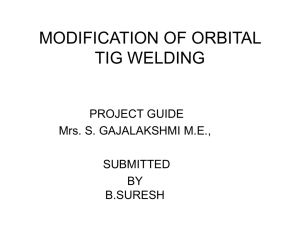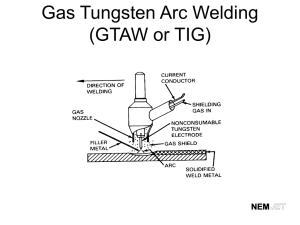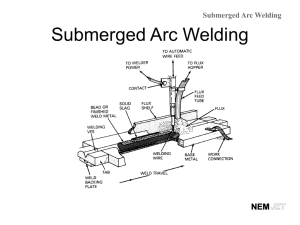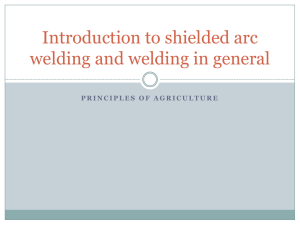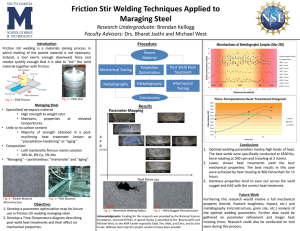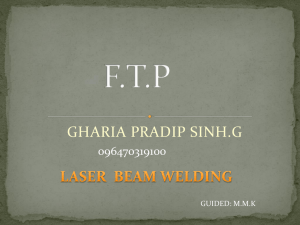History of Welding PowerPoint
advertisement
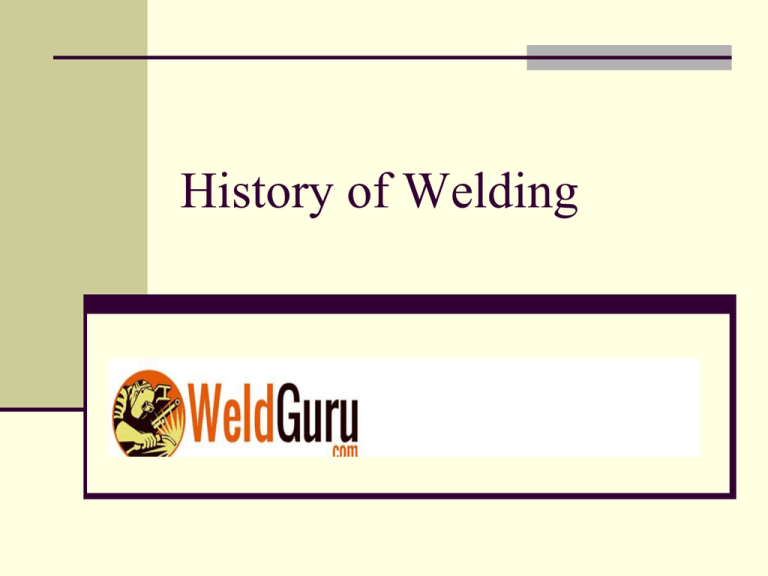
History of Welding History of Welding Welding was used in the construction of the iron pillar in Delhi India, erected about 310 AD and weighing 5.4 metric tons. History of welding Welding, was transformed during the 19th century. In 1802, Russian scientist Vasily Petrov discovered the electric arc and subsequently proposed its possible practical applications, including welding. From this many other forms, including current forms, have been born including: Carbon arc welding Alternating current welding Resistance welding Oxyfuel welding 19th Century 1800-1850s Scientists are using the oxy-hydrogen blowpipe as a laboratory tool to examine refractory metals to the extreme temperature of 4468°F. 1800 Alessandra Volta discovers that two dissimilar metals connected by a substance became a conductor when moistened, forming a 'Voltaic Cell'. 19th Century (continued) 1801 Sir Humphrey Davy (1778-1829) of London England, experimented and demonstrated the arc between two carbon electrodes using a battery. This was the forerunner to electric-arc lighting. 19th Century (continued) 1828 Wallaston produced sponge platinum and welded it together by cold-pressing, sintering and then hammering while the metal was hot. 1838 Charles Goodyear discovers the vulcanization of rubber, giving rise to the development of rubber hoses for welding gases. Eugene Desbassayrs de Richemont patents a process of fusion welding 19th Century (continued) 1839 Michael Faraday discovers the homopolar device that generates voltage. 1840 Frenchman E. Desbassayns de Richemont invents the first air-hydrogen blowpipe. de Richemont coins the phrase "soudure autogène", improperly translated into English as "autogenous welding". Welding implies solid state whereas fusion welding implies a liquid state. 19th Century (continued) 1841 German H. Rossier used the air-hydrogen blowpipe for soldering lead. 1856 James Joule, an Englishman, first experimented with a bundle of wire in charcoal and welded the wires by heating with an electric current. This was the first example of heating by internal resistance to produce a weld. Years later, Elihu Thomson perfected the process into what will then be known as resistance welding. 19th Century (continued) 1860s An Englishman named Wilde successfully used the theories of Volta and Davy and the primitive electric sources of the time to make "Joins" and received a patent for the earliest form of the art now known as "electric welding". 19th Century (continued 1877-1903 Development of gas welding and cutting, carbon arc and metal arc welding. Elihu Thomson invents a low-pressure resistance welding machine which was accomplished by causing internal resistance enough to reach the plastic stage of a metal. Later, it was referred to as Incandescent Welding. 19th Century 1881 Auguste DeMeritens working at an associated laboratory founded by the periodical "l'Electricien" - Cabot Laboratory (Cabat), France was using arc heat to join lead plates for storage battery. French Patent Number 146010 was issued. 1885 Nikolai N. Benardos (Bernados) and Stanislav Olszewaski (Olszewaski) secured a British patent with carbon arc welding. 19th Century (continued) 1886 N. N. Benardos obtained Russian Patent (No. 11982) electric arc welding with carbon electrode called ""Elecktrogefest" or "Electrohephaestus". 19th Century (continued) 1887 N.N. Benardos and S. Olszewaski secured an American Patent for the welding apparatus. The "blowpipe" or "torch", using the gases acetylene and liquefied air or oxygen, was developed. Thomas Fletcher develops blowpipe that could be used with either hydrogen or coal gas and oxygen An English shop began making tanks, casks, and iron garden furniture with the electric arc process. 19th Century (continued) 1888 Benardos/Olczewski granted patent 12984 for Carbon Arc Welding. 1889 Hans Zerner is issued German Patent 53502.3.12.1889 for the Twin Carbon Arc welding process?. C. Coffin is issued patent 395878, 'Process of Electric Welding'. 19th Century (continued) 1890 C. L. Coffin in Detroit Michigan awarded first U.S. Patent (No. 419032, Jan 1) for metal electrodes. This was the first record of metal melted from an electrode and actually carried across the arc to deposit filler metal in the joint to make the weld. One electrode was carbon and the other electrode was filler material. Coffin also described the GTAW beginnings when a weld was made in non-oxidizing atmospheres. 19th Century (continued) 1886-1898 Elihu Thompson of the Thompson Welding Co. invented Resistance Welding (RW). History of welding Until the end of the 19th century, the only welding process was forge welding, which blacksmiths had used for centuries to join iron and steel by heating and hammering them. Arc welding and oxyfuel welding were among the first processes to develop late in the century, and resistance welding followed soon after. 20th Century 1900 E. Fouch and F. Picard develops oxyacetylene torch in France. 1907 Siemund-Wienzell Electric Welding Co. patents a metal arc welding method. Lincoln Electric Company began by manufacturing electric motors in 1895. By 1907, Lincoln Electric were manufacturing the first variable voltage DC welding machine. 20th Century 1907-1914 Oscar Kjellberg (pronounced 'Shellberg') of Sweden and the ESAB (Elektriska SvetsningsAtkieBolaget) Company invented the covered or coated electrode by dipping bare iron wire in thick mixtures of carbonates and silicates. 1908 Oscar Kjellberg received Patent No. 231733 for the coated welding electrode. N. N. Benardos develops electroslag welding process. 20th Century 1912 Lincoln Electric Co. introduces the first welding machines after experimentation started in 1907. E. G. Budd Spot Welds (SW) the first automobile body in Philadelphia, Pennsylvania. 20th Century 1913 Avery and Fisher develop the acetylene cylinder in Indianapolis, Indiana. 1917 Because of a gas shortage in England during World War I, the use electric arc welding to manufacture bombs, mines, and torpedoes became the primary fabrication method. 20th Century 1917-1920 During World War I, a Dutchman, Anthony Fokker, began using welding in the production of Fuselages in German fighter planes. HMS Fulagar (Fullagar) was first all welded hull vessel - Great Britain. The repair of sabotaged German ships in New York Harbor highlighted the first important use welding because the German merchant marines tried to destroy the ships boilers on 109 ships 20th Century 1920s Various welding electrodes were developed: Mild steels electrodes for welding steels of less than 0.20% carbon; Higher carbon and alloy electrodes; and Copper alloy rods. The automotive industry began using Automatic Welding with a bare wire fed to the workpiece to the production of differential housings. 20th Century 1920 P.O. Nobel of General Electric Company developed automatic welding, using Direct Current (DC) using the arc voltage to regulate feed rate. Torch brazing is in full swing using silver and gold filler metals and mineral fluxes as protective cover. 20th Century 1924 1st all-welded steel buildings constructed in U.S. by General Boiler Co. "to the exclusion of rivets". Resistance, gas and metallic arc welding in the manufacturing of all steel automobile bodies at the E.G. Budd Manufacturing Company. Mechanical flash welder used for joining rails together. 20th Century 1926 H.M. Hobart and P.K. Devers used atmospheres of Helium and Argon for welding with a bare rod inside the atmosphere. 1928 In East Pittsburgh, Pennsylvania, on the Turtle Creek, America's First All-Welded Railroad Bridge was erected by Westinghouse Electric and Manufacturing Company. 20th Century 1929 Lincoln Electric Co. started production of heavy coated electrodes (Fleetweld 5) and sold the electrodes to the public 1930 Specifications for welding electrodes were beginning to be written. H. M. Hobart issued Patent for "Arc Welding" and P. K. Devers was issued Patent for "Arc Welding” r using a concentric nozzle with a wire feed. This became known later as Gas Metal Arc Welding (GMAW). History of welding World War I and World War II caused a major surge in the use of welding processes, with the various military powers attempting to determine which of the several new welding processes would be best. 20th Century (continued) 1931 E. G. Budd Manufacturing Company of Philadelphia spot welded stainless steel (18-8) and built the Privateer. The spot-welding was a process called "shotwelding" a proprietary process developed by E.G. Budd. 1932 Submerged Arc Welding (SAW) developed by National Tube Company. Used in late 30s and early 40s in shipyards and ordnance factories. 20th Century (continued) 1934 1st All-welded Excavator - HARNISCHFAGER Corp. 1st All-welded British bridge - Middlesborough, England Lloyd's Rules for pressure vessels permits inspection using X-Ray technology. 1937 BS 538: Metal arc welding in mild steel, was issued, legitimizing arc welding structural applications. 20th Century (continued) 1938 The German Shipbuilding Industry uses welding extensively to reduce the weight of warships and increase the overall size of the ship. This restriction was put in place after World War I. 1940s With World War II GTAW was found to be useful for welding magnesium in fighter planes, and later found it could weld stainless steel and aluminum. 20th Century (continued) 1940 Gas shielded metal arc welding developed by Hobart and Devers at Battelle Memorial Institute. 1942 Chief of Research, V. H. Pavlecka, and engineer Russ Meredith of Northrup Aircraft Inc. designed the Gas Tungsten Arc Welding (GTAW) process to weld magnesium and stainless steel. Alternate names are TIG (tungsten inert gas) and Argonarc and Heliarc. 20th Century (continued) 1944 1st Low-hydrogen electrodes used in fabrication of alloy armor tanks vehicles by the Heil Corp in response to the chrome and nickel shortages from World War II for the U.S. Army. 20th Century (continued) 1946 Spray weld Process (US Patent 2361962) issued to Wall-Colmonoy uses an alloy powder spray which produces a smooth, welded deposits. General Electric Co. Ltd (UK) invents the Cold Pressure Welding Process. High Frequency (HF) stabilized AC tungstenarc welding is used for aluminum alloys. 20th Century (continued) 1948 The Ohio State University Board of Trustees established the Department of Welding Engineering on January 1 as the first of its kind for a Welding Engineering cirriculum at a University. Air Reduction Company develops the InertGas Metal-Arc (MIG) process. SIGMA Welding (Shielded Inert Gas Metal Arc) was developed to weld plate greater than1/8 inch instead of the "Heli-Arc" welding process. 20th Century (continued) 1950s Electron Beam (EB) welding process developed in France by J. A. Stohr of the French Atomic Energy Commission. Wave soldering is introduced to keep up with the demand of Printed Wiring Boards used in the electronics age. Research on testing of brazed joint begins as serious endeavor for the next ten years. Electroslag Welding (ESW) is developed at the E. O. Paton Welding Institute, Ukraine USSR. 20th Century (continued) 1951 Russia use Electroslag Welding (ESW) process in production. The Philip Roden Co. of Milwaukee Wisconsin announces the DryRod electrode oven. 1953 Modifying the Gas Metal Arc Welding (GMAW) process, Lyubavskii and Novoshilov used CO2 with consumable electrodes. 20th Century (continued) 1954 Bernard develops DualShield (Flux Cored Arc Welding (FCAW))- Shielding comes from Gas shielding outer and with gas generated from the arc welding. Lincoln Electric introduces a cored wire without the outer shielding gas (No-gas welding) but the shielding is provided by the flux within the core wire. 20th Century (continued) 1957 Flux Cored-Arc Welding (FCAW) patented and reintroduced by National Cylinder Gas Co. Plasma Arc Welding (PAW) Process developed by Robert M. Gage 20th Century (continued) 1958 The Soviet Union introduced the Electroslag Welding (ESW) Process at the Brussels World Fair in Belgium. 1959 Electroslag welding first used at the Electromotive Division of General Motors and was called the "Electro-Molding Process". Development of Inside-Outside Electrode which did not require an external gas shielding - Innershield from Lincoln Electric Co. 20th Century (continued) 1962 The Mercury Space Capsule is formed using inner and outer titanium shell, seam welded together using a three-phase resistance welder by Sciaky. 1965-1967 CO2 lasers are developed for cutting and welding. 20th Century (continued) 1969 The Russian Welding Program in Space began by producing Electron Beam welds on SOYUZ-6. Welding an AMG6 and DM-20 aluminum alloys with the Vulkan process. 1971 British Welding Institute (Houldcroft) adds oxidizing gas jet around laser beam to develop laser cutting. 20th Century (continued) 1973 The American Astronauts used Electron Beam welding process in June 1973 welding Aluminum Alloy 2219-T87, Stainless 304 and Pure Tantalum. 1976 First automotive production application of lasers weld begins with General Motors Corporation 20th Century (continued) 1983 Homopolar pulse welding variation of the upset welding process research begins at the University of Texas at Austin at the Center for Electromechanics. 1996 Over 7,00,000 brazements are produced for the aircraft industry in the US and Canada. Over 132,010,00 units of brazed automotive parts are produce. 21st Century 2000 Magnetic Pulse Welding (MPW) is introduced by Pulsar Ltd. of Israel using capacitive power as a solid state welding process. 21st Century Areas for Future Innovation Welding operations must be more completely integrated into agile manufacturing processes and process control schemes. Welding will become increasingly automated as it is integrated into the entire manufacturing design and coordinated with improved information systems. 21st Century Areas for Future Innovation (continued) Future products requiring welded joints will be composed of designed-to-be-weldable materials, such as highstrength steels that are also smart materials containing embedded computer chips to monitor the weldment’s lifecycle performance. Such materials could create new opportunities for using welding as a joining technique in the coming decades. 21st Century Areas for Future Innovation (continued) In the future, the modeling of welding will be part of the new emphasis on integrating welding across the entire manufacturing cycle Welding and materials engineers will develop new materials and adapt existing materials, which are specifically designed to be welded into world-class, fabricated products. The development of materials that will reduce energy requirements References Welding History Weld Guru Vision for Welding Industry

